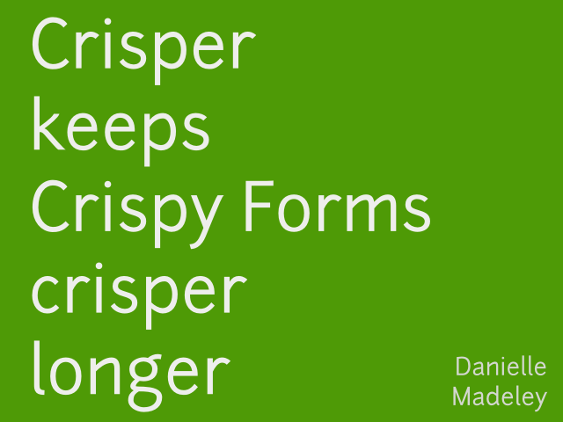I’m at PyCon Au. ((Thanks to Infoxchange, who sent me, and are also sponsoring the conference.)) I made it this year. There were no unexpected collisions in the week leading up to it.
I decided at the last moment to do a lightning talk on a piece of Django-tech I put together at Infoxchange, a thing called Crisper, which I use in a very form-heavy app I’m developing. Crisper is going to be up on Github, just as soon as I have time to extract it from the codebase it’s part of (which mostly consists of working out where it’s pointlessly coupled).
The title of my post relates to deciding to do this talk, and the amazing free and open graphic design assets I have available at my fingertips to create an instant title slide. 5 minutes in Inkscape, using the Tango palette and Junction (available in Fedora as tlomt-junction-fonts) and Inkscape to put together things like this:
Anyway so some pretty good content today at DjangoCon Au. I especially enjoyed the food for thought about whether we should be targeting new development at Python 3. It has struck me that writing greenfields code on Python 2 is a dead end that will eventually result in my having to port it anyway. Thinking I will conduct a quick stocktake of the dependencies we’re using at work to evaluate a Python 3 port. I think generally we’re writing pretty compatible code using modern Python syntax, so from the point of view of our apps, at port at this stage would be fairly straightforward.
Some interesting discussion too on the future of frameworks like Django. Is the future microframeworks + rich JS on the frontend using Angular or Ember. How do things like Django adapt to that? Even though JS has nothing on Python, is the future node.js on the back and somethingJS on the front? ((It always cracked me up that my previous web-app was this HTML5-y app, but designed without the use of frameworks. Old and new both at once.))
~
This is actually a nice aside that I’ve been working on a pure in-web app for visualising data from Redmine using D3.js and Redmine’s RESTful API. ((https://github.com/danni/redmine-viz)) Intending to add configuration in localstorage (probably via Angular) once I have the visualisations looking good. It both serves a practical purpose and an interesting experiment on writing web apps without a web server.
~
Almost back on topic, I had dinner with a bunch of cyclists tonight, and got to talking about my crowd-sourced cycle maps project, ((https://github.com/danni/cycle-router)) which hasn’t gone anywhere because I still don’t have any hosting for it. I should try having dinner with cyclists who work for PaaS hosting providers. ((I need PostGres 9.2 and PostGIS 2.0. Come chat to me!))
Finally, I’m trying to recruit talented web developers who have a love of Agile, test driven design and Python. Also a technical tester. Come and talk to me.


